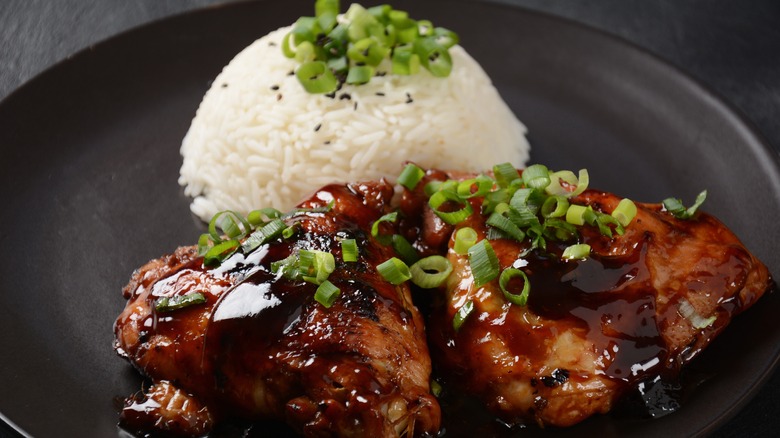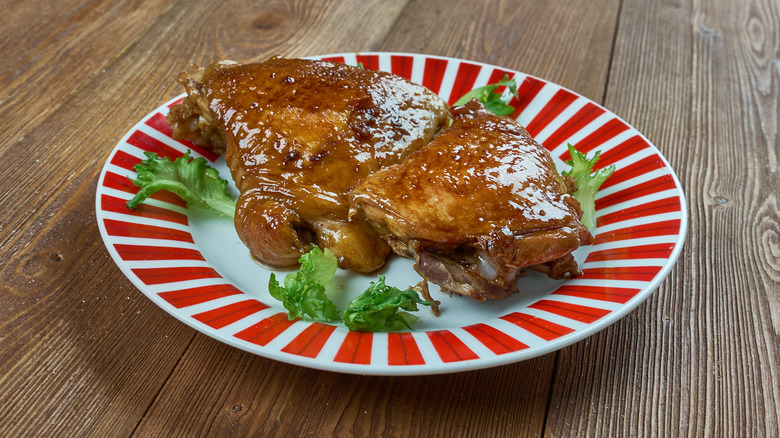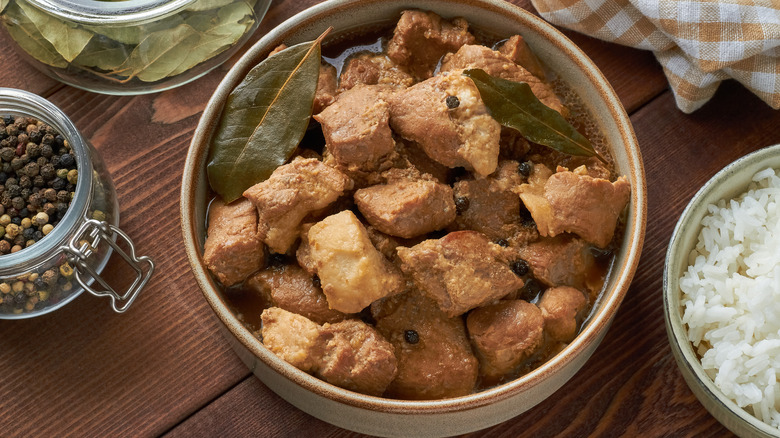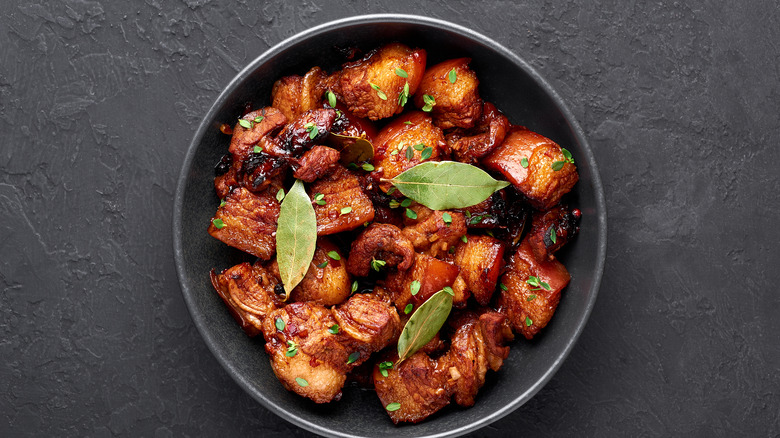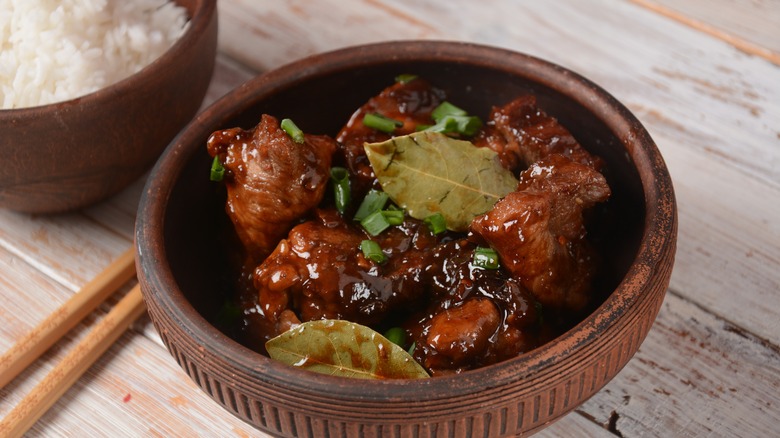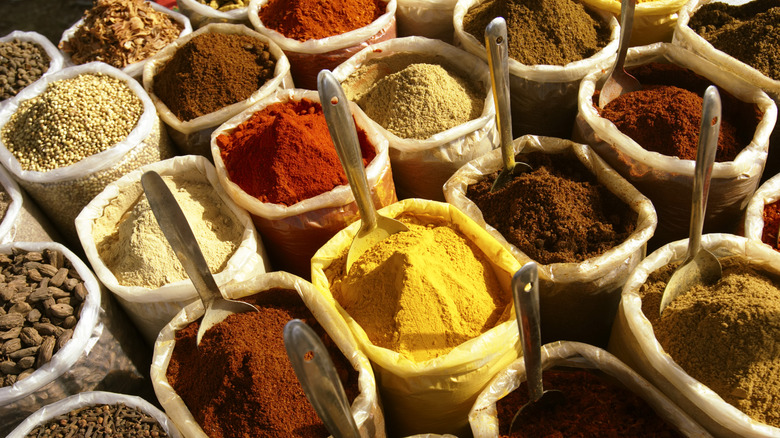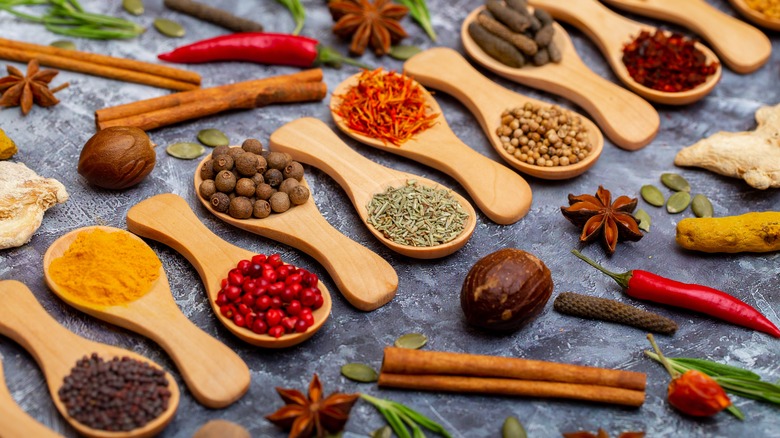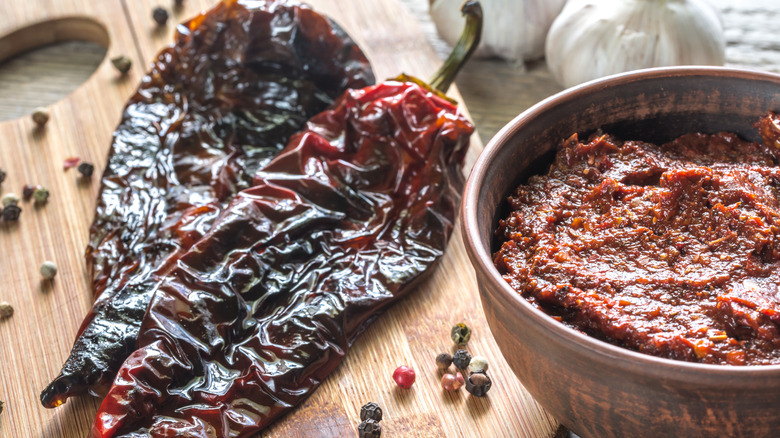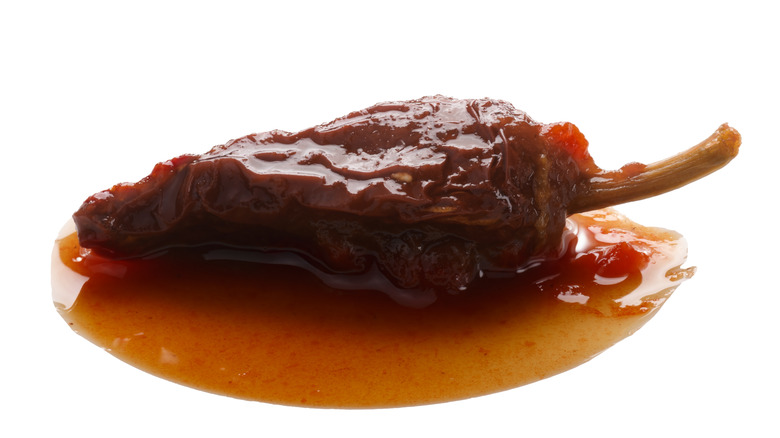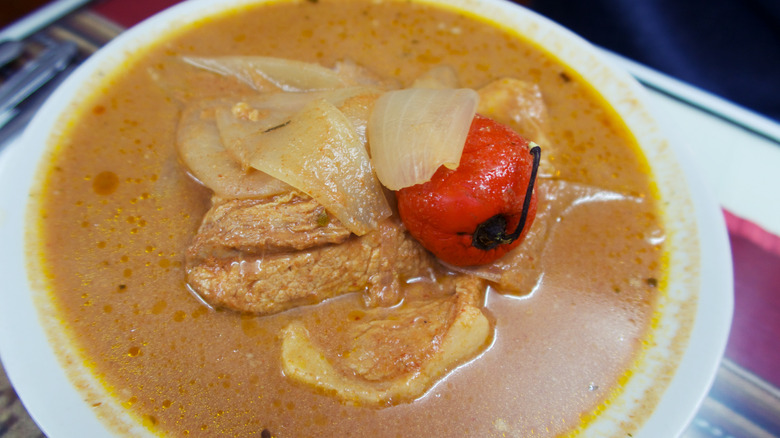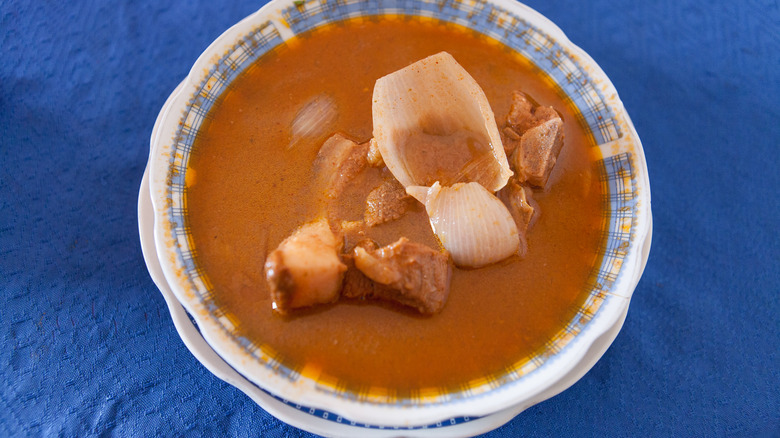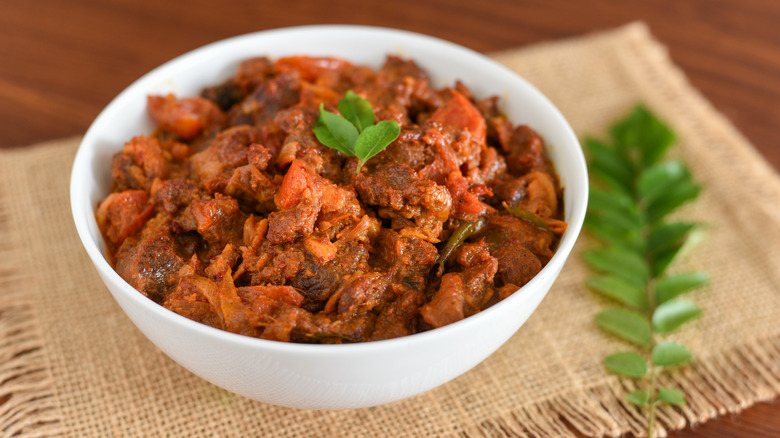Everything You Should Know About Adobo And Its Definitive Styles
For millions of people around the world, especially those in Spain's former colonies, the word "adobo" is enough to make one's mouth water — it's comfort food beyond compare, and for many, a source of regional or local pride and identity. How exactly to define adobo, however, has been a matter of debate: The Spanish word "adobo" basically means a marinade. But in practice, almost no one thinks of adobo as just that. Rather, it's typically a flavorful stew or braise that features a highly seasoned, typically tangy, sauce.
To further complicate matters, adobo fans around the world argue passionately over which adobo is the "real" one — the vinegary Filipino version, the chile-laden Mexican one, or the many variants in Puerto Rico and elsewhere in the Caribbean? The answer is all of them are the real thing – each evolved in its own community using local ingredients and honed to local tastes. So just as American and English football are different games that happen to share the same name, all the world's succulent versions of adobo are different (though often historically related) dishes with a common name. And all are worth seeking out.
Spanish adobo is a tangy marinade
Adobo has long roots in Spain and Portugal, where vinegar was used as a preservative for meat in the era before refrigeration. While it initially served a purely hygienic purpose, it eventually became an expected part of the flavor profile of the cooked meat — over time, cooks started to add seasonings, including garlic, spices, olive oil, and sometimes wine, to the vinegar before cooking the meat.
And while cooks in Spain today have easy access to refrigerators and freezers, modern Spanish adobo recipes reflect the dish's origins by making a long soak in vinegar an integral part of the dish. The meat isn't just braised in a vinegar-based sauce, it's marinated in it for an extended period (sometimes several days) before cooking. Typical Spanish adobo seasonings include garlic, hot and/or sweet paprika, and herbs such as oregano and thyme, and can vary according to the type of meat being cooked. Adobo became popular enough among Spanish diners that explorers and settlers brought the technique with them to their new colonies in the Americas and the Caribbean — and locals in many of these places enjoyed it enough to devise their own versions.
Adobo is the Philippines' national dish – and predates Spanish colonization
Among the most passionate fans of adobo are people with roots in the Philippines, where it's the de facto national dish. Like Spanish adobo, it's a hearty braise of poultry or meat that gets its distinctive tang from vinegar and typically includes garlic. Unlike its Spanish counterpart, however, most versions also include soy sauce. But apart from these signature ingredients, recipes can vary between cooks and regions, with some versions including coconut milk for extra richness and other calling for specific types of vinegar, such as rice vinegar or palm vinegar.
While the recipe and name suggest Filipino adobo was a local adaptation of the Spanish recipe, it is in fact a modernized version of an indigenous dish. Cultures in warm climates around the world, including in the Philippines, independently discovered that vinegar serves as an effective food preservative — and Filipino cooks were preserving and cooking fish and other proteins in vinegar made from native produce such as coconuts and palm fruit long before the Spanish arrived. For this reason, some patriotic Filipinos endorse ditching the Spanish name and using the original Tagalog term for the method of cooking food in vinegar, kinilaw, instead.
Modern Filipino adobo recipes reflect trade and colonization
Filipino cooks and eaters proudly claim adobo as their own, and consider the dish one of the crown jewels of their national cuisine. And it has deep roots in the country's history — long before Spanish colonization, Filipino cooks were making their own vinegar from local fruit and using it to both preserve and season food, including dishes that could be considered precursors to modern-day adobo.
But if you're familiar with the world's major cuisines and look at a typical modern Filipino adobo recipe, you'll notice something unusual: The ingredients come from literally all over the map. All the recipes will contain some kind of vinegar (sometimes from indigenous coconut or palm fruit , sometimes from introduced white or rice vinegar), and most will include garlic and bay leaves (popular ingredients in Spanish adobo), as well as soy sauce (introduced by Chinese traders and immigrants to the Philippines). In short, today's Filipino adobo is a culinary reflection of the country's long history of colonization and contact. While few of the ingredients used today are uniquely Filipino, the way creative cooks combine them and make them truly their own is a point of national pride.
A Filipina chef introduced adobo to the White House
For many Filipinos, adobo is too good to remain a family secret, and proud cooks are eager to share its wonders with diners from other backgrounds. And one of these cooks had an unprecedented opportunity to share her culinary culture — including adobo — on a global stage. When Cristeta Comerford was named White House executive chef in 2005, she became the first woman, the first minority, and the first Filipina to hold the position. And it was a very big deal. "I'll make a confession ... I did Google myself at the time. And there were all these articles in different languages, and they all said the same thing, the White House chef is female. And it's such a great feeling," she told Asia Society.
Comerford took advantage of the opportunity to introduce Filipino dishes and flavorings to the White House kitchen, all while realizing she was cooking for a rarified audience expecting more than just home-cooked food. " ... of course, Filipino cuisine is innately in me — all of mom's recipes," she added. "So I may not serve a big heaping pile of adobo, but I'll use it as a stuffing for another dish." And her adobo earned her a high-profile fan. On a visit to the Philippines, then-President Obama gave Comerford a special shout-out. "Thanks to her, we in the White House enjoy the occasional lumpia and adobo," he said in a toast at a state dinner in Manila.
When brought to Puerto Rico, adobo transformed into an all-purpose seasoning
When Spanish explorers arrived in the Caribbean in the 1490s, they brought their culinary traditions with them — including adobo. But as is often the case for immigrants settling in a new part of the world, they found it difficult to obtain many of the ingredients commonly used back home — in this case, standard adobo ingredients such as fresh garlic, olive oil, and wine. This forced them to improvise, seasoning their meat with a combination of dry spices instead of a vinegary marinade. And while this was a completely different cooking method, some of the more obtainable adobo ingredients (dried seasonings such as paprika and oregano) remained, as did the name adobo.
Today, if you use the term "adobo" in Puerto Rico and some of the surrounding islands, cooks will automatically think of a dry spice blend that typically includes salt, powdered garlic, oregano, cumin, and turmeric, as well as other flavorings. It's not only used as a dry brine to enhance the flavor of meat, but as a seasoning for sauces and vegetables. Some eaters even enjoy sprinkling it on popcorn. In addition, in a nod to Spanish adobo, some cooks mix it with sour orange juice or vinegar to make a wet seasoning paste for meats.
By tradition, Puerto Rican cooks use different adobo blends for different meats
Recipes for Puerto Rican adobo mixtures are variable, with cooks and families each adding their own personal touches. While garlic powder, salt, dried oregano, and black pepper seem to be common components, other popular ingredients can include turmeric and paprika (in part for the attractive orange color they provide) as well as spices such as coriander and cumin.
And while some cooks have a go-to recipe (or store-bought blend) that they use as an all-purpose flavor enhancer, serious traditional cooks vary their adobo recipes to suit the main ingredient in the dish they're making, especially when using a wet adobo mixture. Denser, heavier meats that are slow-cooked will be seasoned with a more aggressive adobo mixture and a more acidic liquid, such as vinegar — the stronger seasonings are needed to fully permeate and stand up to the rich meat. Delicate proteins such as fish are cooked with a more subtly seasoned adobo mixture and a less-aggressive acid that won't overwhelm its flavor, such as citrus juice.
A popular brand of Puerto Rican-style adobo mix became a political flashpoint
Adobo is such an essential part of Puerto Rican cooking that serious Puerto Rican cooks always have it in the kitchen. Its popularity led to the rise of pre-made, packaged adobo mixtures, which became a godsend for busy home cooks. One of the best-known brands of powdered adobo is the Latin food purveyor Goya, which introduced its packaged adobo in 1966. Today, its orange boxes of adobo, which now come in a range of different flavors and styles, are a familiar sight on supermarket shelves.
But in 2020, the company got a big helping of bad publicity that turned loyal fans away from Goya's adobo and other products. When Goya CEO Robert Unanue gave a speech lavishly praising then-President Trump, many Latinos felt hurt and betrayed – how could one of their own support a president who called Mexican immigrants drug smugglers and rapists and supported the separation of immigrant children from their parents at the border? Their outrage grew into a Goya boycott, with prominent Puerto Rican-Americans swearing they'd get their adobo fix elsewhere. "Oh look, it's the sound of me Googling 'how to make your own adobo,'" New York congressional representative Alexandra Ocasio-Cortez tweeted. "Hamilton" composer Lin-Manuel Miranda was equally resolute. "We learned to bake bread in this pandemic, we can learn to make our own adobo con pimienta," he said (via Salon).
Mexican cooks transformed adobo into a spicy sauce
As foods are introduced to new locations, they almost (inevitably) take on a new, local flavor — either to suit the tastes of the local population, to compensate for the unavailability of traditional ingredients, to make use of locally available ingredients, or a combination of these. When the Spanish claimed Mexico as a colony in 1519, they learned to cook with locally grown chiles, which had long been used in the kitchens of indigenous Mexican cooks. Some of these chiles made their way into new versions of adobo, which used ground chiles to enhance the traditional vinegar-and-spice base of Spanish adobo.
Over time, the chiles became the central feature of Mexican adobo and the once-essential vinegar became purely optional – some modern recipes don't use it at all. Today, Mexican adobo is a flavorful braise made with a flavor base of rehydrated and puréed dry chiles, garlic, and seasonings including pepper, cinnamon, cumin, oregano, and cloves. Mexican-style adobo can be served as a main course stew or even as a taco filling.
Chipotles en adobo are a well-known Mexican adobo preparation
If you want to experience Mexican adobo at home without a lot of cooking, head to the international foods aisle at your supermarket and get yourself a can of chipotles en adobo. In this traditional Mexican preparation, chipotles, which are dried, smoked jalapeño peppers, are stewed in a tangy, tomato-based sauce. These stewed chiles are hot, smoky, tangy, and a little sweet.
While delicious, they're a bit too intense to eat on their own. Rather, they're meant to be used to add flavor to other dishes. Chopped and stirred into mayonnaise, they make a great, smoky sauce for fish tacos. Stir some into a pot of beans or soup to add another layer of spice and flavor. They also add a spicy, smoky note to dips, marinades, grilling glazes, and other sauces. And if you're a vegetarian (or trying to cut back on meat) and find yourself missing the smoky vibe of good barbecue, chipotles en adobo will help you satisfy that craving.
Peruvian adobo is traditionally made with fermented corn beer
When the Spanish arrived in Peru in the early 1500s, they brought the word "adobo" with them. It's not clear, though, if they introduced their method of making adobo (marinating meat in vinegar and seasonings before cooking) to the locals. Similar methods of food preservation evolved independently around the world, and historical accounts from the early years of Spanish settlement claim that indigenous women created a stew of meat marinated in chicha, a sour, fermented corn beverage, to seduce Spanish soldiers. This seems to suggest that native Peruvians may have already been familiar with the technique when the Spanish arrived. In any case, the attempt to seduce was at least partially successful — the stew (now called adobo) was and continues to be a point of pride in Peru, especially in the city of Arequipa, where it's a local specialty.
Peruvian adobo combines elements of both Spanish and Mexican adobo. Traditional versions consist of meat marinated and braised in a tangy chicha-based broth thickened and seasoned with aji panca and rocoto peppers, along with garlic, onions, and spices. Chica can be hard to obtain outside Peru, but you can make it yourself (the very basic fermentation involved takes just a few days) or use vinegar, hard cider, or kombucha as substitutes.
There are right and wrong ways to eat Peruvian adobo
Adobo seems to become a point of local pride wherever it goes and however it evolves. And Peruvian adobo is no exception. In the Cayma district of Arequipa, widely considered the epicenter of Peruvian adobo production, a distinctive culture and sense of local identity has arisen around adobo and its enjoyment. Arequipa was historically an Inca stronghold, and the signature ingredient of Peruvian adobo, chicha (a fizzy, sour fermented corn beverage), was a favorite beverage of the Incas and is now considered by other Peruvians to be a distinctive feature of Arequipa's cuisine.
Those visiting Arequipa in search of adobo know Sundays are the best time to go, since that's when the city's many family-owned restaurants cook it up (traditionally in clay pots) for diners to enjoy before or after Mass. The main square in the Cayma district is lined with restaurants offering the dish. Natives of Arequipa also know the one right way to enjoy adobo is with bread (while visitors from nearby Lima like to eat it with rice). And the mandatory drink to sip with your adobo is a shot of anisette (though Peruvians from other regions might wash it down with more chicha).
Indian vindaloo is a direct descendent of Iberian adobo
At first glance the history of adobo's spread around the world seems pretty straightforward: Wherever Spanish colonization took place, some form of adobo followed. And in places that already had their own versions of vinegar-cooked meat, the word adobo was adopted to represent them. But in reality, the appeal of adobo transcends the Spanish-speaking world, and it found its way (albeit under different names), into some unexpected places.
Spain wasn't the only European country to make its own adobo. Its neighbor to the west, Portugal, had its own, very similar version of garlicky meat stewed in vinegar, called carne de vinha d'alhos. Like Spain, Portugal was on an aggressive campaign of colonization in the 15th and 16th centuries. Among its many colonies was the state of Goa in India, which it controlled from 1510 to 1961. The Portuguese, like the Spanish, brought their food with them, and locals adopted (and adapted) many of their recipes. And one of these was the Portuguese version of adobo. Vinegar wasn't available locally, but Portuguese settlers devised a way to make it from coconut toddy, a popular drink. They added local spices such as tamarind, cinnamon, and cloves to the mixture — and because they could, hot chiles they'd acquired from their New World colonies. Locals challenged by the pronunciation of vinha d'alhos simplified it to vindaloo, now considered an Indian classic.

